
Water is essential for so many parts of our day. Beyond just drinking water, we use it in cooking, cleaning and bathing. Most of us are using tap water for all of these applications and most of us have no filters on our water at all.
Toxins that we ingest can be particularly harmful, and oftentimes we have no idea what’s in our water at all. Until recently, many of us trusted that our water was pure and completely safe for us and our families. I know that every time a report is published that sheds light on just what is in our tap water, I am again, shocked. Usually this is followed by frustration – not only for myself, but for everyone else.
Gone are the days of blindly trusting that what I buy, eat and drink is healthy and safe. I’ve come to the realization that I must research and verify these things on my own. But tap water can be a tough one to navigate when you’re trying to figure out if it really is safe.
After all, our water comes from different areas at different times of the year and can change over time. What’s more is that our water sources are not necessarily constantly monitored to ensure they’re free from all contaminants. This is exactly why I think it’s so important to test your tap water at home and secondly filter your water all the time. Understanding what you need to remove from your water is the best way you can help reduce the contaminant levels. Without the knowledge, you may be inefficiently using a filter or system that isn’t right for your home.
WHY IT’S IMPORTANT TO TEST YOUR TAP WATER
As painful as it may be to know what’s really in your water, I think this is the BEST way to start when you’re looking to get a filtration system for your home.
The biggest reason you want this knowledge on your side is because it will help you determine WHICH filter is going to work the best to remove contaminants from your water. Areas of the country can vary drastically when it comes to tap water. If you live in an area with a lot of agriculture and farms, you have a higher risk of pesticide contaminants and nitrates, which will be filtered out differently in comparison to high levels of chlorine byproducts often found in urban areas.
When you’re trying to figure out which filter is going to work best for your house and for your family’s needs, it’s essential to know what you need to filter out of the water and if you’ll need a whole house filter system or if you can get a point of use system just for your cooking and drinking water.
And really, the BIGGEST reason you should have your water tested completely is because it’s extremely important to know if you’ve been exposed to toxins that you need to seek medical help to detox from. Lead in water, especially for kids is a SERIOUS because this type of toxin builds up in their systems and can lead to long term health risks. The problem with ingesting toxins is that they’re taking a one way trip directly to your bloodstream, and on the way affecting your gut and other systems.
Having your water tested at home is vital to your health and wellness and TapScore is who I recommend to all my clients.
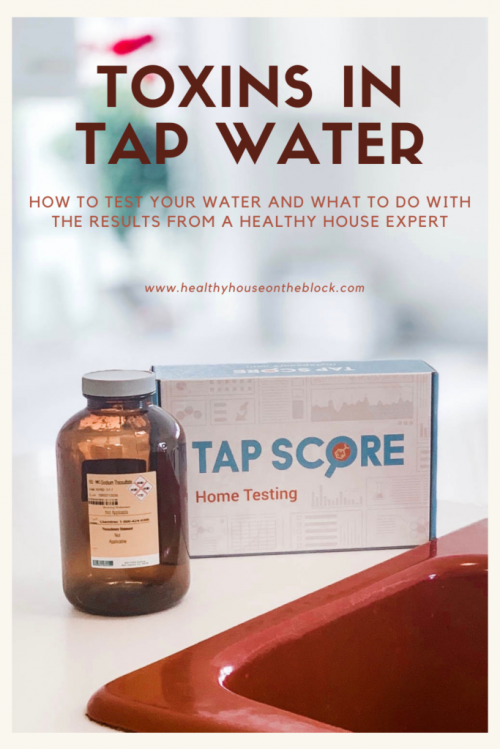
HOW TO TEST YOUR TAP WATER
I remember not all that long ago I hunted and searched for a company that would test my water — and not just to sell me a water conditioning system. I wanted a comprehensive, full report of my tap water. I wanted to know more than just what the pH was, I wanted to know if there were pesticides, and if the levels of chlorine were more than what my city was reporting.
Finally, I came across Tap Score, and I found the EASIEST, most comprehensive report I’ve seen from a do-it-yourself kit. I think we can all agree that most of the time what we want is just the details, no selling. You just want to know how you might have been exposed to a contaminant and then you want to know just how to fix it.
First, you need to know if your home has city water or well water. The tests are slightly different for each of these as there are different concerns for water from a well or water from a city. City water is often more contaminated with chlorine byproducts because water is sanitized before reaching your home to remove bacteria. Well water can contain higher levels of bacteria because there is no sanitizing system in place for an individual well.
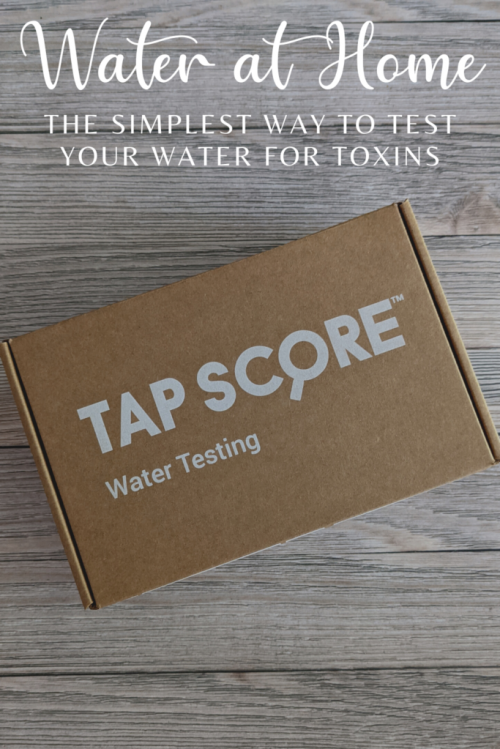
TapScore has water collections for both city and well water, which covers a wide array of typical contaminants. For example, the test for city tap water includes testing for VOCs, disinfection byproducts (from chlorine), heavy metals, nitrates, and minerals. The test will also tell you a little bit about your water’s characteristics, like the pH levels and hardness of your water. You can also get a few of their add-on tests if there’s a particular contaminant you’re worried about in your area.
The TapScore tests are SO simple, which is exactly why I love them. They will mail you a vial with instructions and a prepaid return container and label. You’ll just fill up the vial and then fill out the information card. From there you can mail in your tap water sample and wait for the results, which will arrive by email.
TapScore also has a few options to add on DIY tests that you can perform at home for bacteria and chlorine, which can give you a quick look at a potential problem with your water.
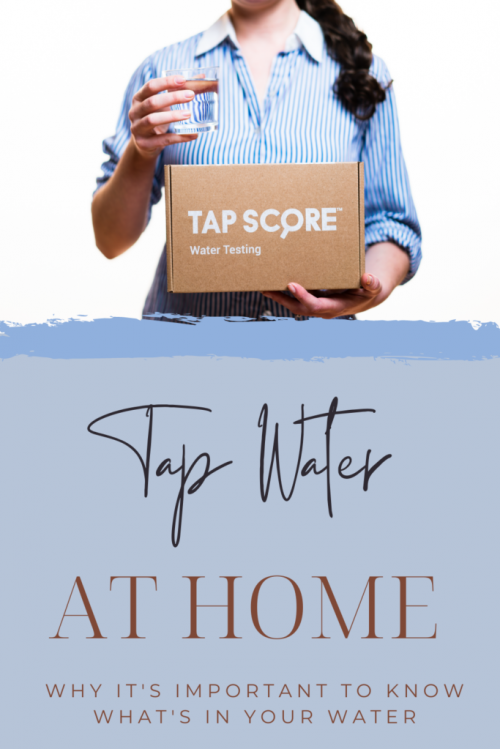
WHAT TO DO WITH THE RESULTS
Once you have your results, you’ll need to address the issues that have been detected. Again, I think the biggest hurdle in this whole process of cleaning your water at home is knowing what to get out in the first place.
The report that comes back from TapScore will help you understand the levels of each contaminant in your drinking water. The next step you’ll take is to choose a type of water filter that will remove most of the contaminants that have been detected.
Depending on what you find, you may want an entire house system to filter the water out for showers, baths, cleaning and cooking. Or, perhaps you’ll only need a filter that is specific to drinking water.
The real key here is to KNOW what’s in your water specifically. Without this knowledge of what is actually in your tap water, you run the risk of getting a water filter that won’t even filter out the toxic contaminant.
The results are also really helpful in terms of your health and your family’s health. Many of these forever chemicals and toxins build up within our systems, and especially within children. If you continue to be exposed to toxins and chemicals in water, the body isn’t able to detox them out fast enough, leaving you with a body that is constantly working to just get back to normal.
It’s what we refer to as body burden – when the body is burdened with constant toxins and can’t get them all detoxed out fast enough. Oftentimes this is when a lot of immune system issues arise and skin issues show up. These are signs that something bigger is going on with our health and possibly our water or environment.
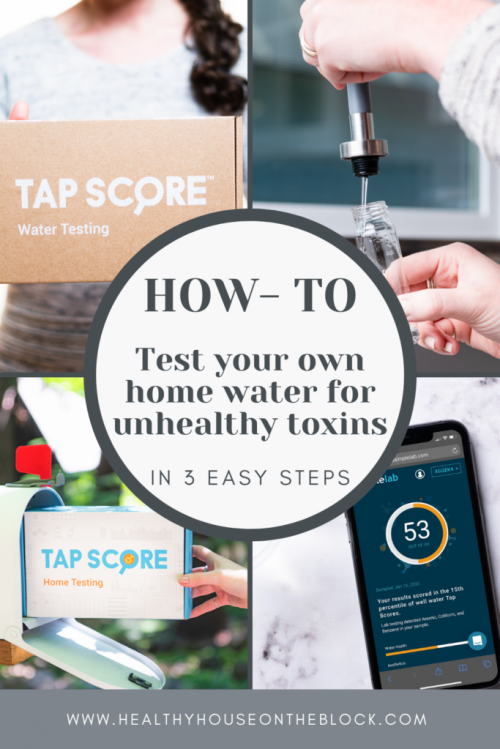
THE TOXINS YOU NEED TO GET OUT RIGHT AWAY
While I think it’s important to make changes quickly and swiftly if you have a problem, some contaminants are more alarming than others. These toxins are red flags to me as an inspector and healthy home expert, and I recommend intervening right away with the solutions mentioned:
Lead: Lead is unable to be used by our bodies and therefore, it is absorbed and stored in our tissue, bones and teeth. Children absorb much more lead when ingested in comparison to adults and it can re-enter the blood stream and circulate throughout the body instead of being detoxed (2010 ENVIRON HEALTH PERSPECT).
Lead exposure can result in some really awful health complications in children, including slowed growth, lower IQ, behavior problems, learning problems hyperactivity, anemia and hearing problems. If you’re pregnant, lead can cause premature birth and can reduce the growth of the fetus. And even in adults, lead exposure can lead to decreased kidney function, reproductive problems and increased blood pressure. (EPA INFORMATION)
Arsenic: Arsenic has recently been identified in several communities, and is often a result of improper disposal of waste. Arsenic in tap water has been linked to an increased risk of cancer and is a known carcinogen. It has also been linked to a rise in diabetes, neurological effects such as memory function and intellectual function, especially when exposure happens during childhood.
Arsenic in tap water has also been linked to cardiovascular disorders and diseases and has been shown to have an impact on pregnant women, causing preterm birth and increased risk of stillbirth. (HEALTH EFFECTS OF ARSENIC EXPOSURE, 2014)
Mercury: Mercury is another toxin that should be tested for in tap water as it is a naturally occurring metal that comes from soil and rock. It can also come from various sources of waste, like burning of fossil fuels and medical waste (NCPH 2009)
Mercury is most closely associated with neurological and behavioral disorders. It has also been linked to tremors, insomnia, memory ost, headaches and issues with the immune system, lungs and kidneys. It’s a serious toxin that is very poisonous to the body and should be filtered out immediately. (WHO)
Radon or Radioactive Substances: Normally, radon is tested for in the air within our homes, but radon can also be in our water sources. The same concern for lung damage applies when there is radon in our drinking water as it gets into the air through evaporation when water is used at home.
Radon in drinking water can also lead to an increased risk of stomach cancer as the toxin is ingested as well as inhaled. (EPA) It has also been linked to bladder cancer when ingested.
Nitrates: Nitrates can be found in groundwater, especially in areas with a lot of agricultural activity. Nitrates in water can be deadly for infants under six months old as it binds to the hemoglobin in their blood, restricting the amount of oxygen in their blood. It has also been linked to birth defects when ingested by pregnant mothers.
Nitrates have been linked to different types of cancers that affect the stomach and gastrointestinal tract. (ENVIRON RES PUBLIC HEALTH 2018)
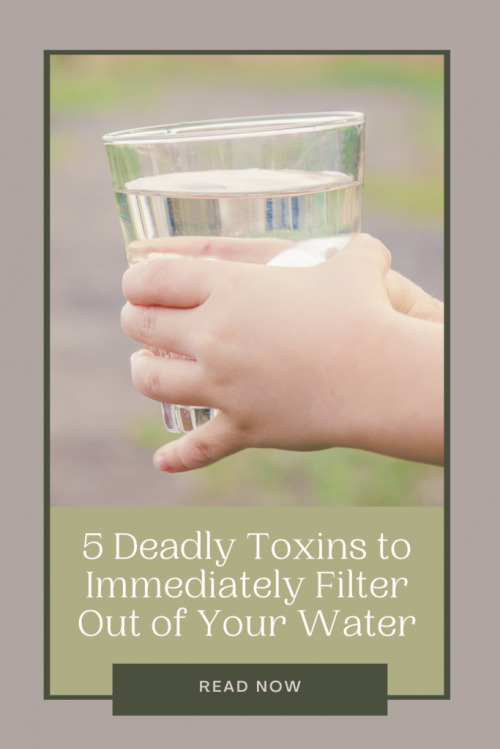
WATER FILTERS THAT CAN HELP
This under sink water filter system will decrease chlorine and effectively absorb lead, chloramine, fluoride, heavy metals, VOCs and much more. Because the filter uses KDF media, it is also efficient at removing Mercury.
This reverse osmosis filter uses a .00001 micron activated carbon block filter that removes atrazine, salt, nitrates, PFAS, fluoride, heavy metals and arsenic as well as more. It improves the taste and smell of your water to be near perfect.
This three stage under counter water filter system uses three separate filters to remove chlorine, bad tastes, radon, bacteria, particles and more.




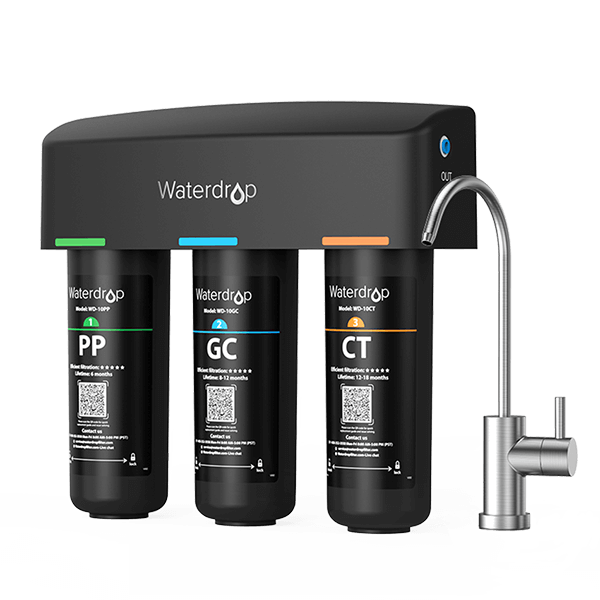


Pingback: Environmental Toxins and Indoor Air Quality Monitors
Pingback: Toxic Heavy Metals Symptoms from Home Exposure »